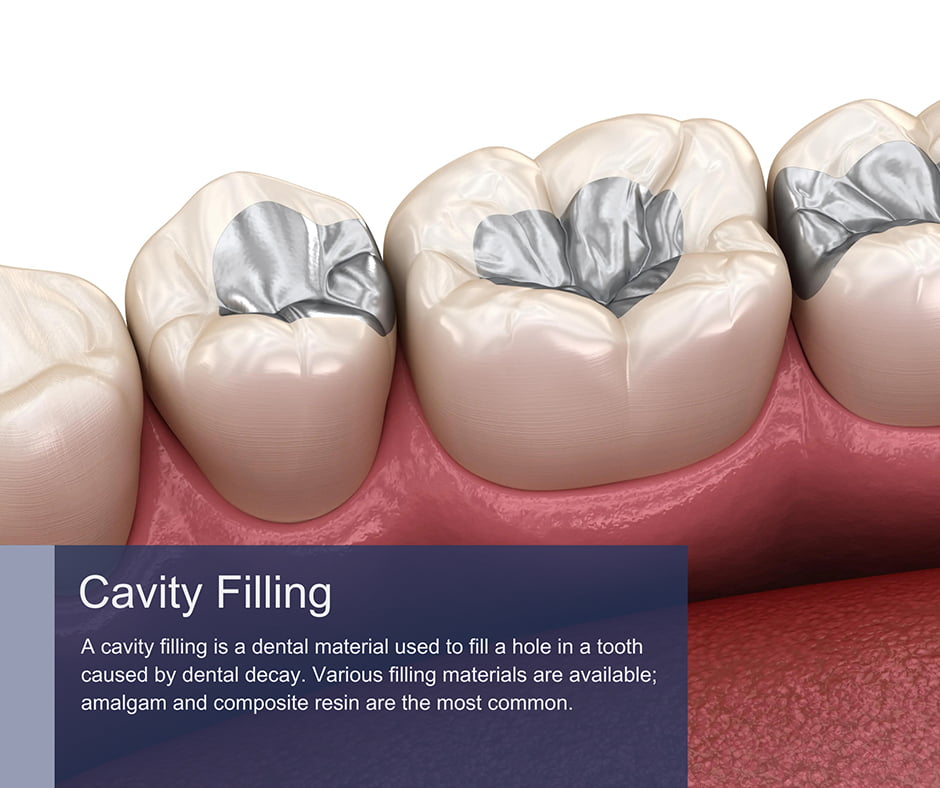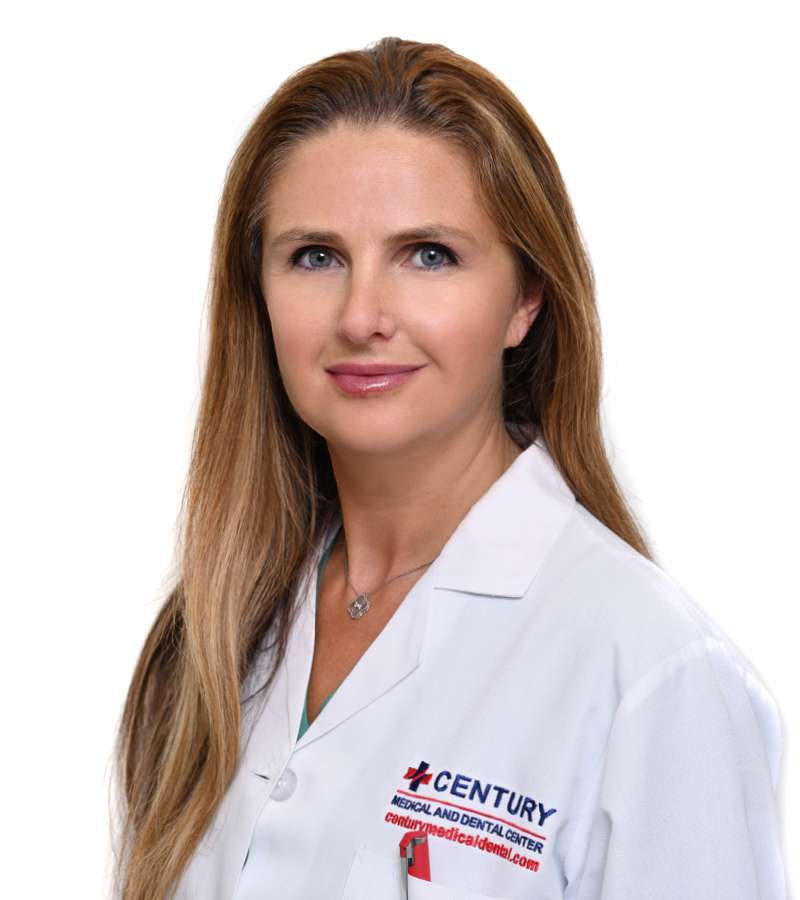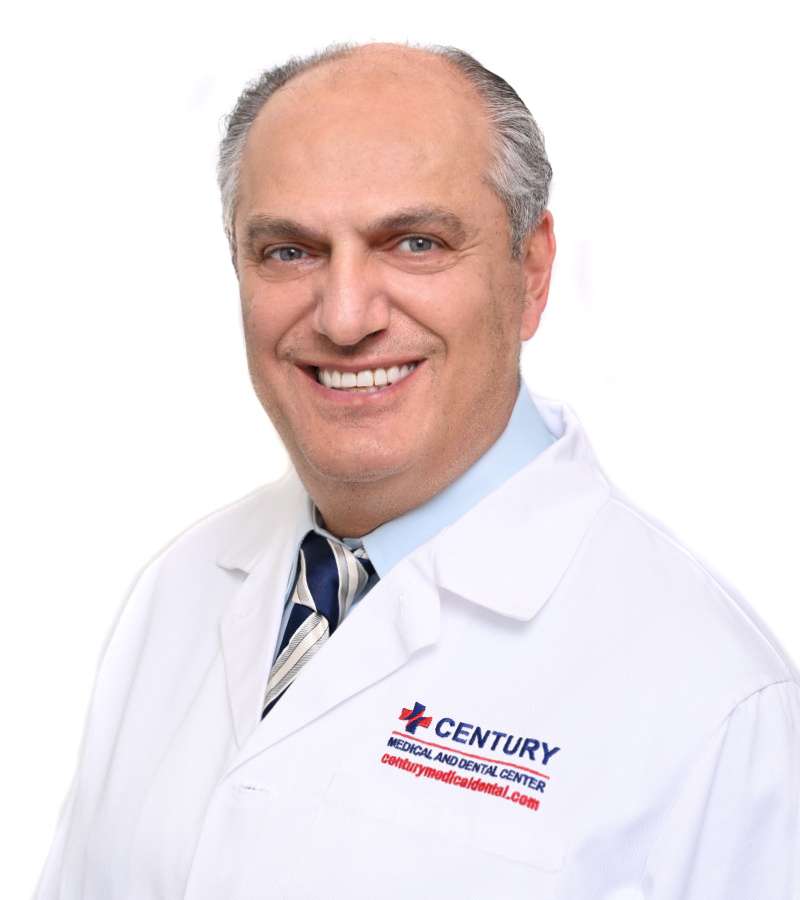Table of contents
Cavity filling is a simple and effective general dentistry procedure used to restore teeth damaged by decay. A tooth cavity is one of the most common dental problems worldwide, and most people will need at least one or two fillings during their lifetime. When a cavity is detected early enough, a filling can easily repair it, helping preserve and protect most of the healthy tooth structure. Without treatment, there is a considerable risk that the cavity will become larger and eventually reach the dental pulp, causing a painful tooth infection that could lead to tooth loss.
Anyone can develop tooth decay and need a dental filling. However, certain conditions can increase the risk of cavities. These include eating too many sugary or starchy foods, especially between meals, poor oral hygiene, and dental problems like dry mouth. Good preventive dental care can greatly reduce these risks, and when you first visit Century Dental, we assess your risk of dental problems, including cavities.
We can then devise your custom preventive dental care plan. This will include the frequency of dental checkups and hygiene appointments, and we can work closely with you to ensure your daily oral care routine is excellent. If you need a cavity filled, we can provide the most appropriate dental care, using the best techniques and materials to restore the tooth.

A cavity filling is a dental material used to fill a hole in a tooth caused by dental decay. Various filling materials are available; amalgam and composite resin are the most common.
Amalgam fillings have been used for over a century and contain mercury and other metals. They are durable and long-lasting but are highly visible when smiling and therefore tend only to be used when restoring cavities in back teeth.
Composite resin fillings are newer and are tooth colored, making them virtually invisible. Composite resin is reasonably durable and ideal for restoring cavities in front teeth or anywhere in the mouth. The material can be used to repair small to medium-sized cavities.
If you need a larger filling, which is often the case when restoring back teeth, you will need an inlay or onlay. Instead of being placed directly into the cavity, an inlay or onlay is made in a dental lab using a dental impression of your mouth, called an indirect filling. Inlays and onlays can be made from gold alloy or porcelain, depending on your preference. Both are hard-wearing and long-lasting, so they will need replacing less frequently than an amalgam or composite resin filling.
Amalgam fillings are reliable but are less widely used, and many dental offices are amalgam free as this material is gradually being phased out. Their decline in popularity is due to the introduction of newer, more biocompatible materials like composite resin and concerns about mercury content in amalgam.
Composite resin is a more popular choice for restoring a tooth cavity, not just because it is tooth-colored. The material requires less tooth preparation than amalgam fillings so that we can preserve more of the healthy tooth structure. Composite resin doesn’t flex when it comes under pressure or when exposed to temperature changes in the mouth, for example, when you eat something hot or cold.
Instead, the material closely mimics natural tooth structure and will bond strongly to your tooth, forming a good seal that helps to prevent further infection. Amalgam can flex slightly when subjected to pressure or temperature changes, eventually causing microfractures in teeth that can weaken them over time.
If you have older amalgam fillings and are wondering if they should be replaced, we can assess their condition during your next checkup at Century Dental. No filling lasts forever, and when the time comes, we can ensure that any amalgam fillings are removed safely, and the amalgam is disposed of correctly so it will not harm the environment.

Family Dentist
Brooklyn
Gravesend

Family Dentist
Manhattan
Manhattan

Family Dentist
Brooklyn & Manhattan
Manhattan, Downtown

Dentist
Brooklyn & Manhattan
Gravesend, Manhattan, Downtown

Dentist
Manhattan
Manhattan

Dentist
Brooklyn & Manhattan
Manhattan, Livingston

Dentist
Brooklyn & Manhattan
Manhattan, Livingston
The cost is dependent on the material used to restore your tooth. Amalgam fillings are the cheapest, and composite resin fillings cost a bit more but are very affordable. Indirect fillings such as inlays and onlays cost more, as the materials are more expensive, and they must be made in a dental lab. Dental insurance should cover at least part if not all, the cost of a dental filling. Most people who need a filling will receive a composite filling.
Read more: Cavity Filling Timeline and Recovery
When dealing with teeth weakened by cavities and prone to fractures and infections, choose an experienced team of board-certified dental practitionerswith extensive experience in restorative dentistry. They can providing fillings that restore your tooth’s structure and functionality, allowing for normal chewing and biting.
If you’re seeking a cavity filling, here are a few tips:
The dental specialists at Century Medical and Dental utilize cutting-edge technologies, including Bioactive Materials, 3D printing, and laser dentistry, to deliver more effective and comfortable cavity treatments. These advanced techniques help halt tooth decay progression, protecting teeth from further damage. Whether repairing broken, chipped, or worn teeth, patients benefit from the team’s attention to detail and expertise in a calming, welcoming environment. With a gentle, empathetic staff, comprehensive dental care is conveniently provided at one location, ensuring an excellent patient experience from start to finish.
My biggest problem is waiting for a long time just to see the dentist. But at Century Dentistry Center, you do not have to wait a long time to see the dentist. There they treat you very respectfully.
The process for a composite filling is straightforward. We first numb the tooth using local anesthetic before removing all the decay and infection and shaping the cavity for the filling. Once ready, the cavity is cleaned thoroughly and prepared to receive the composite resin to ensure the material bonds strongly to your tooth.
Our dentist will select a shade of composite resin closely matching the tooth’s natural color and inserts the material into the cavity in small increments, hardening it regularly with light. Once all the material is in place and is fully cured and hardened, it is shaped and polished, and we will check your bite carefully. Once complete, your new filling should be virtually invisible.
You must wait until the anesthetic wears off before eating and drinking anything hot; otherwise, you could burn your mouth. It is not unusual for a new filling to feel a bit strange or slightly sensitive for a few days afterward until the tooth settles down.
Your new composite resin filling should last several years, but it can begin to stain over time. It will stain more quickly if you smoke or eat and drink a lot of highly colored foods and beverages. Regular hygiene appointments will help to keep it looking good for longer.
We check the condition of all restorations during your checkups and can discuss when to replace them. If you notice a filling has become chipped or damaged or think it is failing, please contact us immediately so we can assess it and place a new filling to continue protecting the tooth.
Cavities are common, but ensuring you have regular dental checkups enables us to detect small lesions or holes in your teeth more quickly. The sooner we can fill a tooth, the more likely we only need to place a small, inexpensive filling to protect and restore the tooth.
Century Medical and Dental Center is an accredited healthcare facility in NY that operates in accordance with Article 28, a public health law. This law regulates and recognizes accreditation for public healthcare facilities, ensuring they are licensed and operated correctly. By undergoing the Article 28 process and achieving accreditation, Century Medical and Dental Center demonstrates its commitment to meeting the highest standards of care.
As a multidisciplinary medical center, we have highly qualified doctors, nurses, and support staff who are working hard to provide the best medical care to patients in Midtown Manhattan, NY, Downtown Brooklyn, NY, including Brooklyn Heights, Dumbo, Prospect Heights, Park Slope, Clinton Hill, Boerum Hill, Red Hook, and Bedford-Stuyvesant.